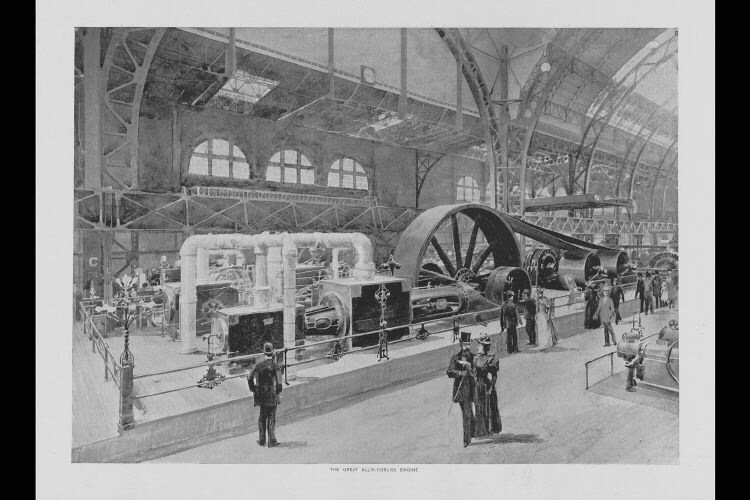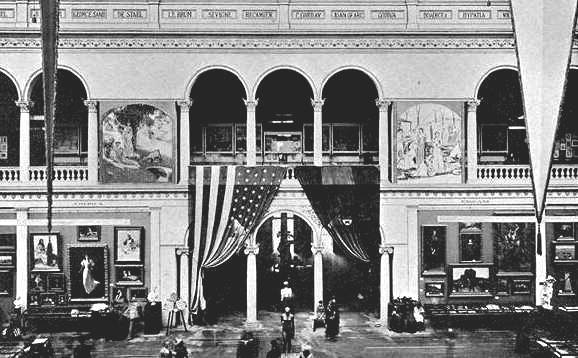
The Allis-Corliss Engine on exhibit in the Machinery Building at the 1893 Columbia Exposition. The engine took up 3,000 feet of floor space and powered two dynamos that provided electricity to sections of the Fair. The fly wheel was 30 feet in diameter. (Source)
Objective: This activity will help you better understand the experiences of people designing or experiencing the Columbian Exposition/World’s Fair of 1893. It also will give you some practice synthesizing diverse historical sources, as well as walk you through how to engage with both primary and secondary sources. Finally, it should help your final project group to some extent in working on your final project.

An interior view of the Women’s Building at the 1893 Columbian Exposition. (Source)
Instructions
Work with the students in your final project group to complete this activity.
- Select one of the engineered features (e.g., a building, an experience, an exhibition, a ride) of the World’s Fair represented in Erik Larson’s book The Devil in the White City.
- Explain how this feature qualifies as “engineered” based on your own definition of engineering.
- Find this feature in The Book of the Fair. Read how The Book of the Fair describes it.
- Discover how the feature, or one very much like it, is described in another primary or secondary source.
- Compare and contrast the different sources’ (including Larson’s) views of the feature. Explain not only how, but also why the authors of these different texts might view or interpret the feature differently from one another.
- Take a stand. Which author’s interpretation do you find most persuasive, and why?
- Build on that author’s interpretation to make your own argument. Specifically, what habits, beliefs, and values does the feature embody or suggest, and why? Use your two additional sources (The Book of the Fair and one additional source)—or others that you find—as evidence for your own interpretation of this feature.
- On the class blog, share your group’s findings in 5-7 paragraphs. You may organize them with your argument near the top, as in a traditional essay, or you may let your argument unfold over the course of your paragraphs, in something approximating the order represented above.
- Please note: Your blog post title should include the name of the World’s Fair feature you are interpreting. Although you will be posting from a single student’s sign-in, be sure to sign your group’s post with all group members’ names.
- Once the assignment deadline has passed, find another group that has written on this same—or a similar—feature, and share your thoughts on their interpretation of it in a comment on that group’s post. Feel free to ask the other group questions that invite thoughtful responses. You may post comments as a group (with each group comment signed by all members) or as individual students.
Group post due on the course blog by 11 p.m. on TUESDAY, April 19.
Course Learning Objectives
This activity supports the following course learning objectives:
1C. Engage in lively conversations about the past with other students in the course.
1D. Find a relevant, reputable article on the open web.
1E. Locate relevant books in the library catalog.
1F. Find relevant peer-reviewed articles in the library’s subscription databases.
2C. Analyze the work of those historians: identify arguments, evaluate their use of sources, determine the validity of their arguments.
2D. Synthesize the work of scholars to construct a challenging, arguable thesis.
2E. Make novel connections among disparate historical and cultural phenomena.
2F. Draw on objectives 1A-1F while using evidence to support an argument.
3A. Craft a definition of engineering.
3B. Explain how an engineered system reflects habits, beliefs, and values.
3C. Analyze how and explain why, in some situations, people resist engineered systems.